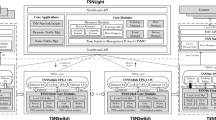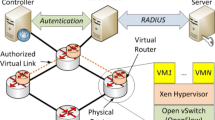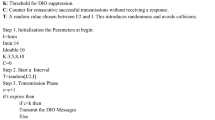Abstract
Current link state routing is based on routing decisions made through distributed interactions among routers. Link state is disseminated by means of flooding, which possesses a few limitations, such as excessive message overhead and network-wide computation. Thus, we propose LSC2, an extended link state routing protocol with centralized control, in this paper to address this problem. In LSC2, link state advertisements (LSAs) are communicated between a centralized element (CE) and a forwarding engine (FE) rather than traditional flooding. Multiple CEs form a separate control network as a representation of the control plane. Through this control network, LSAs are disseminated to FEs in a determinate manner. We also propose a signaling protocol for independent path convergence in the control network, as well as a routing control algorithm to prevent unnecessary routing updates in the forwarding network. We implement a prototype LSC2 and evaluate its performance. Our experiments show that with the use of real topologies, LSC2 can accelerate network convergence and reduce message overhead compared with OSPF. Moreover, LSC2 is robust because having multiple CEs can prevent the occurrence of a single point of failure. LSC2 also scales well with network size by adding additional CEs to share in the processing load.









Similar content being viewed by others
Notes
We use “router” and “FE” interchangeably in the rest of this paper.
References
Basu A, Riecke JG (2001) Stability issues in OSPF routing. In: Proceedings of ACM SIGCOMM, pp 225–236
Császár A, Enyedi G, Hidell M, Révái G, Sjöin P (2007) Converging the evolution of router architectures and IP networks. IEEE Netw Mag 21(4):8–14
Feamster N, Rexford J (2004) The case for separating routing from routers. In: Proceedings of ACM SIGCOMM workshop, pp 5–12
Caesar M, Caldwell D, Feamster N, Rexford J, Shaikh A, van der Merwe J (2005) Design and implementation of a routing control platform. In: Proceedings of 2th USENIX symposium on networked systems design & implementation (NSDI), pp 15–28
Greenberg A, Hjalmtysson G, Maltz DA, Myers A, Rexford J, Xie G, Yan H, Zhan J, Zhang H (2005) A clean slate 4D approach to network control and management. ACM SIGCOMM Comput Commun Rev 35(5):41–54
Yan H, Maltz DA, Eugene Ng TS, Gogineni H, Zhang H, Cai Z (2007) Tesseract: a 4D network control plane. In: Proceedings of 4th USENIX symposium on networked systems design & implementation (NSDI), pp 369–382
Casado M, Freedman MJ, Pettit J, Luo J, McKeown N, Shenker S (2007) Ethane: taking control of the enterprise. ACM SIGCOMM Comput Commun Rev 35(4):1–12
Gude N, Koponen T, Pettit J, Pfaff B, Casado M, McKeown N, Shenker S (2008) NOX: towards an operating system for networks. ACM SIGCOMM Comput Commun Rev 38(3):105–110
Iqbal H, Znati T (2011) On the design of network control and management plane. Comput Netw 55(9):2079–2091
Moy J (1998) OSPF version 2, IETF RFC 2328
Callon R (1990) Use of OSI IS-IS for routing in tcp/ip and dual environments, IETF RFC 1195
Goyal M, Soperi M, Baccelli E, Choudhury G, Shaikh A, Hosseini H, Trivedi K (2012) Improving convergence speed and scalability in OSPF: a survey. IEEE Commun Surv Tutorials 14(2):443–463
Choudhury G (2005) Prioritized treatment of specific ospf version 2 packets and congestion avoidance, IETF RFC 4222
Pillay-Esnault P (2005) OSPF refresh and flooding reduction in stable topologies, IETF RFC 4136
Narvaez P, Siu K-Y, Tzeng H-Y (2000) Fault-tolerant routing in the internet without flooding, dependable network computing. In: Aversky D (ed) Kluwer, pp 193–206
Wu J, Dai F, Lin X, Cao Jiannong, Jia Weijia (2003) An extended fault-tolerant link-state routing protocol in the internet. IEEE Trans Comput 52(10):1298–1311
Levchenko K, Voelker GM, Paturi R, Savage S (2008) XL: an efficient network routing algorithm. In: Proceedings of ACM SIGCOMM, pp 15–26
Dijkstra EW (1959) A note on two problems in connexion with graphs. Numer Math 1(1):269–271
Francois P, Filsfils C, Evans J, Bonaventure O (2005) Achieving sub-second IGP convergence in large IP networks. ACM SIGCOMM Comput Commun Rev 15(3):35–44
Alaettinoglu C, Jacobson V, Yu H (2000) Towards millisecond IGP convergence, internet draft draft-alaettinogly-isis-convergence-00.txt
Thorup M (2003) OSPF areas considered harmful. Private paper
Fu J, Sjödin P, Karlsson Gunnar (2009) Intra-domain Q3 routing convergence with centralized control. Comput Netw 53(18):2985–2996
McKeown N, Anderson T, Balakrishnan H, Parulkar G, Peterson L, Rexford J, Shenker S, Turner J (2008) OpenFlow: enabling innovation in campus networks. ACM Comput Commun Rev 38(2):69–74
Gude N, Koponen T, Pettit J, Pfaff B, Casado M, McKeown N, Shenker S (2008) NOX: toward an operating system for networks. ACM Comput Commun Rev 38(3):105–110
Tootoonchian A, Ganjali Y (2010) Hyperflow: a distributed control plane for openflow. In: Proceedings of INM/WREN
Koponen T, Casado M, Gude N, Stribling J, Poutievski L, Zhu R, Ramanathan M, Iwata Y, Inoue H, Hama T, Shenker S (2010) Onix: a distributed control platform for large-scale production networks. In: Proceedings of operating systems design and implementation, pp 351–364
Yu M, Rexford J, Freedman MJ, Wang J (2010) Scalable flow-based networking with DIFANE. In: Proceedings of ACM SIGCOMM, pp 351–362
Raghavan B, Koponen T, Ghodsi A, Casado M, Ratnasamy S, Shenker Scott (2012) Software-defined internet architecture: decoupling architecture from infrastructure. In: Proceedings of ACM workshop on hot topics in networks (HotNets), pp 43–48
Gibb G, Zeng H, McKeown N (2012) Outsourcing network functionality. In: Proceedings of ACM SIGCOMM workshop on hot topics in software defined networks (HotSDN), pp 73–78
Iqbal H, Znati T (2007) Distributed control plane for 4D architecture. In: Proceedings of IEEE global telecommunications conference, pp 1901–1905
Quagga Routing Suite. http://www.quagga.net
Ahrenholz J (2010) Comparison of CORE network emulation platforms. In: Proceedings of IEEE MILCOM conference, pp 864–869
OpenVZ Linux Containers. http://wiki.openvz.org/
GEANT2 project. http://www.geant2.net/
Spring N, Mahajan R, Wetheral D (2002) Measuring ISP topologies with RocketFuel. In: Proceedings of ACM SIGCOMM, pp 133–145
Katz D, Ward D (2010) Bidirectional forwarding detection (BFD), RFC, p 5880
Acknowledgments
The work described in this paper is supported by the NSFC under Grant No.61103189 and No.61070199, Program for Changjiang Scholars and Innovative Research Team in University (No.IRT 1012), Program for Science and Technology Innovative Research Team in Higher Educational Institutions of Hunan Province: “network technology”, and Hunan Province Natural Science Foundation of China (11JJ7003).
Author information
Authors and Affiliations
Corresponding author
Rights and permissions
About this article
Cite this article
Zhao, D., Wu, C., Hu, X. et al. LSC2: An extended link state protocol with centralized control. Peer-to-Peer Netw. Appl. 8, 651–663 (2015). https://doi.org/10.1007/s12083-013-0226-2
Received:
Accepted:
Published:
Issue Date:
DOI: https://doi.org/10.1007/s12083-013-0226-2




